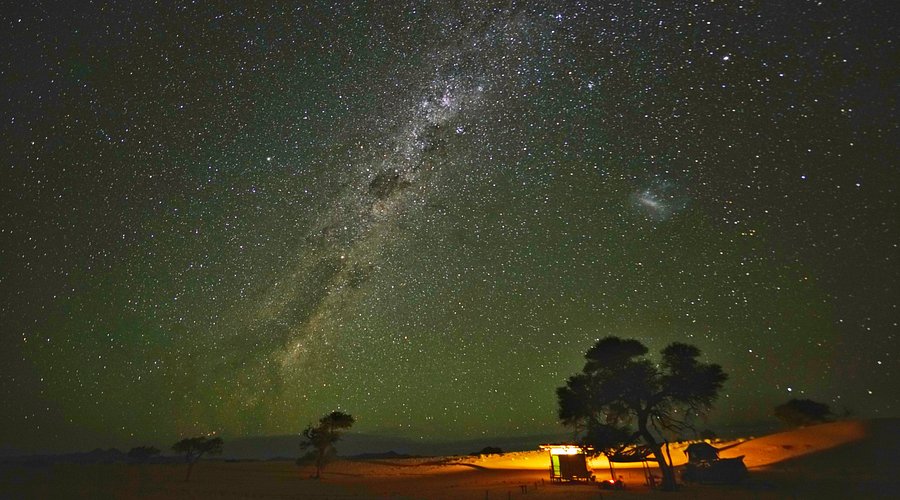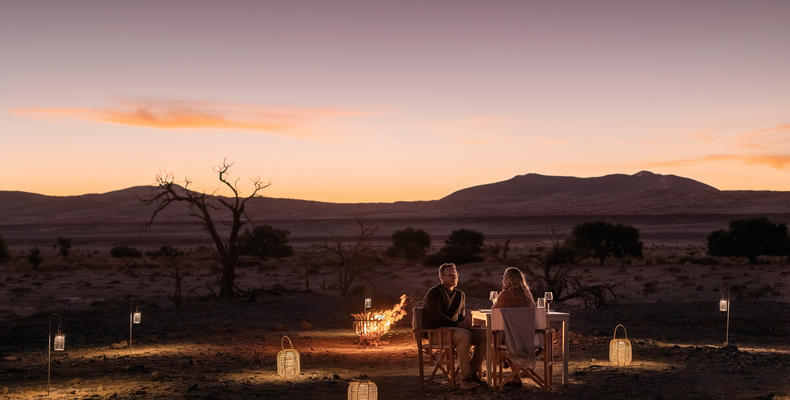Namibia: Finding Silence Under the African Stars

The burnout hit me hard. Years spent hunched over data, chasing the faintest signals from distant exoplanets, had finally taken their toll. The joy of discovery had faded, replaced by a gnawing exhaustion and a profound sense of isolation. I needed to escape, to disconnect from the digital noise and reconnect with something real, something bigger than myself. So, I booked a flight to Namibia. The promise of vast landscapes, profound silence, and unparalleled dark skies beckoned. I was nervous, I confess. Traveling alone, relying solely on my Google Pixel 7 Pro for capturing the majesty of it all felt… daunting. But I was driven by a primal need to find true silence under the vastness of the African night sky, a silence that could hopefully reset my soul.
A breathtaking view of the Namibian desert during sunset, illustrating the expansive landscape and the start of the dark sky experience.
Sossusvlei: Dunes and Solitude
My Namibian adventure began in Sossusvlei, home to some of the highest sand dunes in the world. The alarm blared at an ungodly hour, but the anticipation of sunrise over Dune 45 propelled me out of bed. The pre-dawn chill bit at my exposed skin as I joined the small group of hikers, each of us armed with a flashlight, ready to conquer the sandy giant. The crunch of sand underfoot was the only sound as we ascended, the air thick with anticipation.
And then, the sun began to rise. The eastern horizon ignited with a fiery glow, painting the dunes in a kaleidoscope of colours – from deep crimson to vibrant orange, then softening to pastel hues. The skeletal camel thorn trees at the base of the dune stood in stark contrast to the vibrant landscape, their silhouettes adding a touch of drama to the scene. It was breathtaking, a visual feast that no photograph could truly capture.
Later that day, I took a hot air balloon ride over the Namib Desert. Floating in silence above this ancient landscape was an almost spiritual experience. The patterns of wind-blown sand created intricate designs, revealing the desert's artistry. From above, the sheer scale of the earth became palpable. My anxieties about my research project seemed to shrink into insignificance against the backdrop of this timeless panorama.
Of course, I couldn't resist attempting some astrophotography. Armed with only my Google Pixel 7 Pro, I tried to capture the Milky Way arching across the night sky. The results were… humbling. While my phone managed to pick up some stars, the images paled in comparison to the professional astrophotographs I'd seen online. The difference in detail and clarity was striking. It was a reminder that while technology has made astrophotography more accessible, professional equipment still reigns supreme. However, I was still pleased with the photos I captured, a reminder of the beautiful, vast sky above.
 Anya's attempt at capturing the Milky Way with her Google Pixel 7 Pro, showcasing the beauty that can be captured with modern phones, despite the limitations compared to professional equipment.
Anya's attempt at capturing the Milky Way with her Google Pixel 7 Pro, showcasing the beauty that can be captured with modern phones, despite the limitations compared to professional equipment.
My base in Sossusvlei was the Kulala Desert Lodge, an eco-lodge designed to blend seamlessly with the surrounding landscape. Its commitment to sustainability was impressive, from solar power to water conservation. One evening, I indulged in a locally sourced Oryx steak with baobab chutney. The Oryx was tender and flavourful, while the chutney added a sweet and tangy counterpoint. And then, there were the Mopane worms. Yes, I tried them. I hesitated, I admit, the thought of eating a dried caterpillar not exactly appealing. But I was determined to embrace the local culture. The earthy flavour was surprisingly pleasant, and the texture… well, let's just say it was an experience. I was glad I tried it, and they were surprisingly good.
Etosha National Park: Wildlife and Starlit Skies
From the stark beauty of the desert, I travelled north to Etosha National Park, a vast savannah teeming with wildlife. My destination was the Okaukuejo watering hole, a magnet for animals during the dry season. The landscape here was a stark contrast to Sossusvlei. The cracked earth, shimmering mirages, and sparse vegetation spoke of the harsh realities of the Namibian dry season. I imagined how different it would look after the rains, transformed into a lush grassland bursting with life.
The watering hole was a hive of activity. Elephants lumbered down to drink, their massive forms casting long shadows in the afternoon sun. Giraffes gracefully stretched their necks to reach the water, their elegant movements a mesmerizing ballet. Zebras jostled for space, their black and white stripes creating a dizzying pattern. And then, as dusk approached, a rhino emerged from the shadows, its presence commanding respect. The air was filled with the sounds of the animals – the trumpeting of elephants, the braying of zebras, and the distant roar of a lion. It was a symphony of the wild.
Naturally, I again attempted to photograph the stars. While there was limited light pollution, I realized how much of an effect it still had on the clarity of my photos. I compared my pictures with those from professional photographers, and even though there was a stark difference, the photos I captured reminded me of what my eyes could see.
 A combination of wildlife and the starlit sky in Etosha National Park, showcasing the diverse landscapes and unique stargazing opportunities available in Namibia.
A combination of wildlife and the starlit sky in Etosha National Park, showcasing the diverse landscapes and unique stargazing opportunities available in Namibia.
But it was the stargazing in Etosha that truly captivated me. Away from the city lights, the stars blazed with an intensity I had never witnessed before. The silence was profound, broken only by the occasional call of a nightjar. As I gazed up at the Milky Way, a river of light stretching across the heavens, I felt an overwhelming sense of connection to the universe. My problems, my anxieties, my burnout… they all seemed so insignificant in the face of such vastness. It was a humbling, yet liberating experience. It was here, under the Etosha stars, that I finally began to find the peace I had been searching for.
Practical Tips and Responsible Travel
If you're planning a dark sky tourism trip to Namibia, here are a few tips to keep in mind:
- Optimal times of year: The dry season (May to October) offers the clearest skies.
- Recommended equipment: While professional telescopes and cameras are ideal, even a modern mobile phone can capture stunning images of the night sky. Consider a tripod for stable shots.
- Responsible travel: Minimize light pollution by using red-light torches and avoiding unnecessary lighting. Respect the environment and followLeave No Trace principles. Choose eco-friendly accommodations and support local communities.
- Book tours: Consider booking tours from companies that engage in responsible tourism, to ensure you are traveling responsibly.
Conclusion
My journey to Namibia was more than just a vacation; it was a pilgrimage to silence. Under the vastness of the African night sky, I found solace, perspective, and a renewed sense of purpose. The experience has reinforced my belief in the importance of preserving dark skies, not just for astronomers, but for all of humanity. We need to protect these precious places from light pollution, ensuring that future generations can experience the wonder and awe of a truly dark night. I urge you to support initiatives that protect dark skies and promote sustainable tourism in Namibia. My time there reminded me of how small we are, and the importance of keeping an open mind. I found connection under the African stars, and that experience has changed my perspective on life and the universe.